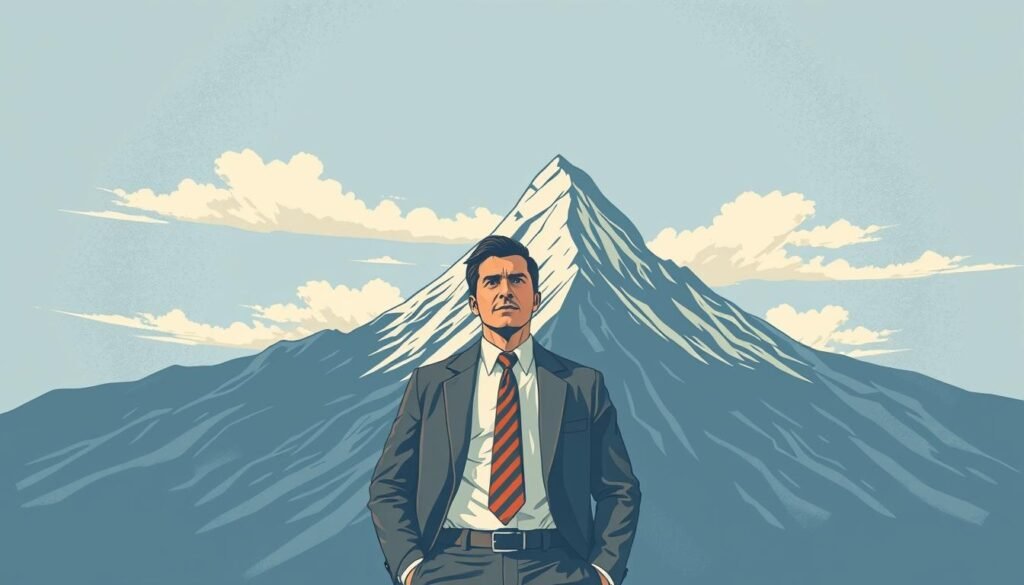Did you know over 50% of small businesses fail in the first five years? Yet, some of the world’s top entrepreneurs bounced back from failure to great success. This article looks at the amazing stories of five famous leaders who overcame big setbacks.
Key Takeaways
- Big names like James Dyson, Walt Disney, Henry Ford, Milton Hershey, and Reid Hoffman faced big failures but came back strong.
- It’s key to understand the psychology of setbacks and common failure patterns to build resilience and recovery.
- Turning failures into learning, building better business models, and staying persistent are key for comebacks.
- The stories of these icons show that even top businesses face challenges. But with the right mindset and actions, they can get even stronger.
- Learning from these entrepreneurs can give us valuable insights and motivation for overcoming business hurdles or rebuilding after a setback.
Understanding Business Failure and Resilience in Entrepreneurship
Starting a business is exciting but also tough. It has highs and lows. We need to know about small business resiliency. This helps us understand the effects of failure and how to bounce back.
By learning from failed startups, we can find ways to start again. This knowledge is very valuable.
The Psychology of Entrepreneurial Setbacks
Business failure hits hard, both personally and emotionally. Entrepreneurs put their all into their work. So, losing it feels like a big blow.
They might feel sad, doubt themselves, and worry about money. The emotional weight of failure is huge.
Common Patterns in Business Failures
- Lack of market understanding: Not knowing what customers want.
- Inadequate financial planning: Not having enough money for the business.
- Ineffective leadership and team dynamics: Trouble building a good team.
- Inability to adapt to changing market conditions: Not adjusting to new trends.
The Role of Resilience in Recovery
Entrepreneurship is full of hurdles, but the key to success is resilience. Being strong and open to learning from mistakes is crucial. This mindset helps entrepreneurs bounce back and do better in the future.
“Failure is simply the opportunity to begin again, this time more intelligently.” – Henry Ford
By understanding the psychology of failure and common mistakes, entrepreneurs can grow. This knowledge helps them face challenges and succeed.
James Dyson: Revolutionizing Home Appliances After Multiple Setbacks
James Dyson’s story shows the strength of bouncing back from business challenges and entrepreneurial perseverance. He faced many failures but never gave up. His hard work and creativity turned him into a billionaire.
Dyson wanted to fix the problem with old vacuum cleaners. They lost suction and needed new bags often. He aimed to make a better vacuum but faced rejection from others.
“I made 5,127 prototypes of my vacuum before I got it right. There were 5,126 failures. But I learned from each one. That’s how I came up with a solution. So I don’t mind failure. I’ve always thought that schoolchildren should be marked by the number of failures they’ve had.”
Dyson didn’t stop trying. He kept improving his design, trying new things. After over 5,000 failures, he made the “Dual Cyclone” vacuum. It worked without bags.
Dyson’s entrepreneurial perseverance and ability to learn from failures led to his success. Today, his company is a global giant, known for its innovative home appliances.
Dyson’s story teaches us that facing challenges can lead to great success. It shows us to see failure as a chance to learn and grow. His journey inspires us to keep going, no matter what.
Walt Disney and Henry Ford: Icons Who Rose Back After Business Failure
Reinventing after failure is key for successful business leaders. Walt Disney and Henry Ford are great examples. They overcame early setbacks to create lasting legacies.
Disney’s Early Struggles and Bankruptcy
Walt Disney faced many challenges early on. His first studio, Laugh-O-Gram, went bankrupt in 1923. This left him broke and feeling down.
He then moved to Hollywood and started the Disney Brothers Studio with his brother Roy. They created Mickey Mouse, but faced another big setback. Their distributor, Columbia Pictures, went bankrupt, leaving Disney in financial trouble again.
Ford’s Initial Business Failures
Henry Ford also had to overcome early failures. His first two car companies failed. He didn’t give up and started the Ford Motor Company in 1903.
This company changed the car industry with the Model T. Ford’s determination paid off in the end.
 Key Success Strategies They Shared
Key Success Strategies They Shared
- Unwavering Persistence: Disney and Ford never gave up, showing the power of resilience.
- Innovative Thinking: They found new opportunities after setbacks, leading to their success.
- Adaptability: They were ready to change their plans, showing the value of being flexible.
The stories of Walt Disney and Henry Ford remind us that reinventing after failure can lead to great success. Their hard work, creativity, and ability to adapt inspire many today.
Milton Hershey and Reid Hoffman: Sweet Success After Bitter Defeats
Entrepreneurial journeys are rarely straight. Milton Hershey and Reid Hoffman show us how to bounce back from bankruptcy and setbacks. Their stories teach us to keep going, even when things get tough.
Milton Hershey’s journey to success was filled with failures. He lost several candy businesses before hitting it big with Hershey’s chocolate bar. His ability to learn from mistakes was key to his success.
Reid Hoffman also faced many challenges before founding LinkedIn. He had setbacks with other ventures, including a struggling social network. But he didn’t give up. He used his experiences to create a platform that changed professional networking forever.
“Failures are often the stepping stones to success. It’s important to embrace them, learn from them, and use them as motivation to keep moving forward.”
Hershey and Hoffman’s stories remind us that success after bankruptcy is possible. They show us the importance of staying strong and learning from our mistakes. Their stories inspire us to face our challenges with hope and determination.
By looking at Hershey and Hoffman’s journeys, we can learn a lot. Their success shows us how to turn failures into strengths. Their stories motivate us to see challenges as chances to grow and achieve our dreams.
Essential Lessons from These Entrepreneurial Comebacks
James Dyson, Walt Disney, Henry Ford, Milton Hershey, and Reid Hoffman share great lessons. Their stories show how to bounce back from failure. They teach us how to make our businesses strong and grow, even when things get tough.
Converting Failures into Learning Opportunities
Successful people see failure as a chance to get better. Lessons from failed startups help them make smarter choices. This leads to stronger businesses in the future.
Building Stronger Business Models
The entrepreneurs in this article show the value of always improving your business. They learned from their mistakes and used new ideas and feedback. This helped them build businesses that last a long time.
The Importance of Persistence
- Staying strong when things get hard is key for entrepreneurs.
- Keeping a positive attitude and never giving up is crucial for small business resiliency.
- Being persistent and open to learning helps turn failures into chances for success.
The stories of these entrepreneurs remind us that we can overcome big challenges. By learning from failures and making our businesses better, we can achieve long-term success.
Conclusion
Entrepreneurs like James Dyson, Walt Disney, Henry Ford, Milton Hershey, and Reid Hoffman show us the power of never giving up. They faced big challenges but kept going. Their stories teach us that with hard work and new ideas, we can overcome any obstacle.
These leaders turned their failures into lessons that made them stronger. They built better businesses and never stopped chasing their dreams. Their stories show us that failure can lead to greatness.
For those starting or growing a business, their stories are a big help. They remind us that success is not always easy. But with the right mindset and determination, we can achieve our goals.
FAQ
What are the key takeaways from the case studies of entrepreneurs who bounced back after business failure?
Key lessons include turning failures into learning chances. Building stronger, more resilient business models is also important. Lastly, persistence is key for long-term success in entrepreneurship.
How did James Dyson revolutionize the vacuum cleaner industry after multiple setbacks?
James Dyson’s journey shows the power of perseverance. Despite many setbacks, Dyson’s innovative problem-solving and refusal to give up led to a multi-billion dollar empire.
What were the early struggles and eventual success stories of Walt Disney and Henry Ford?
Walt Disney and Henry Ford faced early failures. But they used these to build lasting legacies. Their past failures helped them employ key strategies for success.
How did Milton Hershey and Reid Hoffman achieve sweet success after bitter defeats?
Milton Hershey and Reid Hoffman turned past failures into success. Hershey went from failed candy businesses to a chocolate empire. Hoffman went from a struggling social network to founding LinkedIn.
What role does resilience play in the recovery process for entrepreneurs who have faced business failures?
Resilience is key for entrepreneurs facing business failures. It helps them navigate challenges, learn from setbacks, and turn failures into stepping stones for future success.





